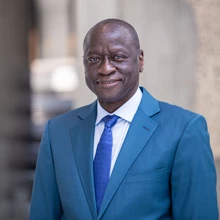 The World Bank is supporting the expansion of energy access through initiatives like the Tanzania Rural Electrification Expansion Program. Photo credit: World Bank.
The World Bank is supporting the expansion of energy access through initiatives like the Tanzania Rural Electrification Expansion Program. Photo credit: World Bank.
Over the past 150 years, leaps in energy technology and availability around the world have made numerous jobs easier, faster, or even obsolete. Think of laundromats replacing laundresses, automation and robots taking the place of workers in assembly lines, and now artificial intelligence-assisted chatbots replacing customer service agents.
The same is true in Africa, but the shift is happening at a much slower pace. In a region where roughly 600 million people still lack access to electricity and many industries are being held back by unreliable or unaffordable electricity, access to energy holds the power to transform economies, increase incomes, and reshape the employment environment for the better.
That is good news for Africa, as the job landscape urgently needs to be disrupted. Across the region, informal and subsistence work still employs the majority of working-age Africans, leaving too many families vulnerable to poverty. Most earn a living through self-employment or micro-businesses, which offer limited scope for investment and growth. Only a small share of workers have access to formal, wage-paying jobs.
Many conditions are necessary for firms to grow and hire better skilled workers, from a conducive business environment to regulatory stability and access to large, attractive markets. But infrastructure, especially access to energy, is a strikingly important ingredient.
It’s no accident that the World Bank Group has made Mission 300, our initiative to provide electricity to 300 million people in Africa by 2030, so central to our work. As we seek to help lift people out of poverty by giving them access to better jobs, energy has become one of the critical levers for change.
We know that affordable and reliable electricity is key for firms seeking to scale operations more efficiently in the region. High electricity costs undermine the competitiveness of private sector firms, often forcing them to rely on manual processes instead of adopting high productivity technologies that require more energy. Unreliable power also remains a major challenge, with blackouts causing major disruptions to business activity and reducing employment rates by an estimated 5 to 14 percentage points.
Firms operating in sectors such as agribusiness, light manufacturing, mining, housing and construction, health care, and tourism could greatly boost productivity through more intensive energy use. (You can find deep dives into the job potential of each of these sectors in the October 2025 edition of Africa’s Pulse.) In health care, for instance, rapid advances in imaging and monitoring require reliable energy and skilled labor to use these technologies. Similarly, tourism depends heavily on modern amenities, including readily available phone charging, Wi-Fi access, and air conditioning. When it comes to temperature control, the largest projected economic impact from climate change on the region—even greater than flooding and droughts—is expected to come from heat stress on workers, making cooling systems essential for employers.
Given how critical energy access is to job creation in the region, the World Bank has committed to leveraging $30 billion in resources from our International Development Association (IDA) over the next five years in support of Mission 300. This represents roughly 20 percent of our current funding for the region.
This level of commitment is matched by governments themselves, who are driving reforms, setting bold targets, and creating the conditions needed to transform their energy sectors through National Energy Compacts. These compacts set ambitious, time-bound goals to expand energy infrastructure at competitive costs, harness the benefits of regional power integration, encourage greater private sector participation to unlock additional resources, and strengthen utilities.
In rural or remote settings, distributed renewable energy is filling critical infrastructure gaps by powering both households and small businesses. For example, in Sierra Leone, demand-driven mini-grids are proving that rural electrification can be commercially viable when linked directly to productive uses like milling, cold storage, and digital services.
On the grid side, we’re bringing electricity to schools, health centers, and other public services to help build a stronger, healthier, and more skilled future workforce. In Ethiopia, energy initiatives are creating jobs across sectors, providing sustainable incomes. One project has already connected more than 8 million people and over 19,000 schools, clinics, and government facilities across Ethiopia.
To date, Tanzania’s Rural Electrification Expansion Program has connected more than 16,000 rural businesses to the electricity grid, from food processing and fish farms to construction and mining, boosting their productivity and enabling growth. In Senegal, the Energy Access and Scale-Up Project aims to bring electricity to 600 health clinics, 200 schools, 700 small and medium-sized enterprises, and 200,000 households. This expansion is creating jobs through installation, maintenance, and electrification supply chains while improving productivity in education, health care, and small businesses.
These engagements reflect broader efforts across the region to transform the energy landscape, with a focus on practical solutions that do more than just turn on the lights—they also create jobs at scale.



Join the Conversation